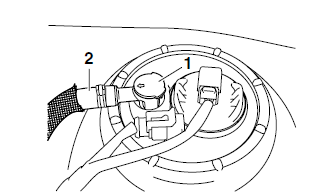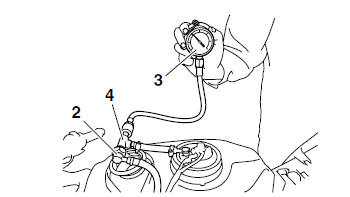Yamaha YZF-R125 Service Manual: Checking the fuel pressure
1. Check:
- Pressure regulator operation
a. Remove the fuel hose connector cover "1" and disconnect the fuel hose "2" from the fuel pump.
| CAUTION: Although the fuel has been removed from the fuel tank, be careful when removing the fuel hose, since there may be fuel remaining in it. |
NOTE:
Before removing the hose, place a few rags in the area under where it will be removed.

b. Connect the pressure gauge "3" and fuel
pressure adapter "4".

c. Start the engine.
d. Measure the fuel pressure. 
Faulty Replace the fuel tank (with fuel pump).
e. Connect the fuel hose and install the fuel hose connector cover.
Refer to "INSTALLING THE FUEL HOSE" on page 7-2.
 Installing the fuel hose
Installing the fuel hose
1. Install:
Fuel hose
Fuel hose connector cover
CAUTION:When installing the fuel hose, make sure
that
it is securely connected, and that the fuel
hose connector cover is in t ...
 Throttle body
Throttle body
...
Other materials:
Checking the front brake master cylinder
1. Check:
Brake master cylinder
Damage/scratches/wear Replace.
Brake fluid delivery passages
(brake master cylinder body)
Obstruction Blow out with
compressed air.
2. Check:
Brake master cylinder reservoir
Cracks/damage Replace the brake
master
cylinder.
Brake maste ...
Intake air temperature sensor
1. Check:
Intake air temperature sensor resistance
Out of specification Replace
the throttle
body.
a. Connect the pocket tester ( ×
1k) to the
throttle body sensor assembly coupler as
shown.
Positive tester probe
brown/white "1"
Negative tester probe
gray/black ...
Troubleshooting
Any of the following fail to light: headlight, high beam indicator light,
taillight, license plate light, auxiliary
light or meter light.
NOTE:
Before troubleshooting, remove the following part(s):
1. Seats
2. Fuel tank
...
